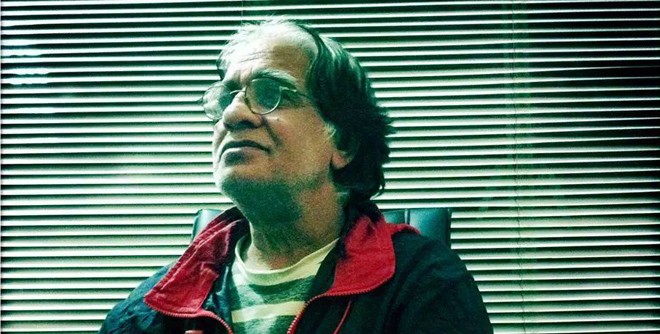
With Ahmad Zoay it was difficult to separate the art from the artist

The sad news of Ahmed Zoay’s death did not reach many people since he had lost touch with his colleagues and fellow artists. He suffered a heart attack on July 10 that he could not survive.
He had been living on the second floor of a house in Samanabad, Lahore, which served more as studio than home. His works were scattered in all rooms along with his painting material; there was no difference between life and art as far as Zoay was concerned.
It was the same house where I met him for the first and the only time. Prior to that eventful afternoon, I used to get late night calls from Ahmed Zoay talking endlessly and passionately about paintings, politics and Punjab. It was difficult to focus on the conversation because he jumped from one subject to the next as quickly as he shifted from Urdu to Punjabi with bits of English in between.
In fact, listening to him was more like glancing at a collage or a traditional patchwork, because each ingredient was separate but, when joined, offered a complete and comprehensive picture.
Seeing him in person was a whole new experience. I went on a Sunday afternoon in 2010, and found him fully charged, surrounded by his works, indulging in his favourite drink rather generously. Without any formal words or niceties (this was our first meeting), he harangued on art and artists of his times with unprintable details which could only be enjoyed when heard.
Zoay had been a student at the National College of Arts in the late 1970s, and a brilliant one. During my student years, I kept hearing about this man who demonstrated his creativity, skill and ease both in the medium of painting and sculpture. But he could not complete his degree for various reasons. According to his own version, these were related to the faculty but it is more likely that the intensity of his personality could not cope with the discipline of an institution.
From that time onwards (and I presume many years before too), Ahmed Zoay was a free soul involved in his chosen activities -- painting and drawing. Like his person that could not be contained in any conventional setup and formal training, the work was free from any bondages and barriers. The artist himself did not believe in any boundaries. In a famous incident, Zoay along with his friends went to the Indian border and insisted on entering the country. For him a line between two countries or provinces which share the same culture, history and language was insignificant and irrelevant.
But the irony of art is that the concept of freedom is dealt with in a peculiar and uncanny way here. If no restrictions are imposed (mainly from the creative person, in the form of routine, such as work hours at the studio, selection of imagery, and limitations of medium) then the freedom itself becomes the biggest construct of confinement. Often, the work rotates (and is rehashed) in a similar scheme, without much change or development.
Ahmed Zoay’s work unfortunately faced the same situation. Arguably, his isolation from the art world and his distance from his contemporaries caused a kind of repetition and predictability in his work. His strong colours, vivid tones and wild brush strokes appeared regular marks observed in canvas after canvas. Perhaps Zoay, like every intelligent painter, was aware of this aspect of his art. So he desperately sought the company of others but, with his uncontrollable nature and unpredictable behaviour, there was minimum or no contact with other artists.
This sense of solitariness transformed him into a person who was sure of himself on one level but was trying to find his true identity on another. He experimented with a range of materials and techniques but, analysed as a whole, his work ceases to surprise after a while.
It was perhaps the aura of the artist that took over his oeuvre. His untamed personality seemed more interesting, exciting and extraordinary than what he was producing. During that long afternoon on Sunday, he discussed his past, his parents, his years at NCA, his marriage, daughters, other painters and the problems of Pakistani society and its politics. Switching from Punjabi to Urdu and changing from formal to frank form of address, his speech was something that normally one does not come across, even among artists who are supposed to be eccentrics.
Ahmed Zoay was an odd man, even in that class of eccentrics. His outlandish remarks about his own family, his country, the founding fathers of Pakistan and religion can not be quoted but these disclosed the true nature or task of an artist, who is bold enough to challenge every taboo and is not scared to question or criticise what is sacred.
Those few hours with him were the most memorable of the times that I have spent with an artist. I was already familiar with his work and so was not too keen on looking at canvas after canvas and going through his drawings stored in many portfolios. It was his words that shock me to the extent that I decided to write all about the visit, about him, his ideas and his way of living. I wanted to write about how an artist could break all barriers of thoughts and was courageous enough to pronounce all those disturbing comments openly and in front of a stranger.
This plan to write the piece got delayed for many reasons (cowardliness and cautiousness being the prime ones). His death finally forced me to write about it. Would it be okay to say Rest in Peace Ahmad Zoay? For all I know, he’d be active and agitated instead!